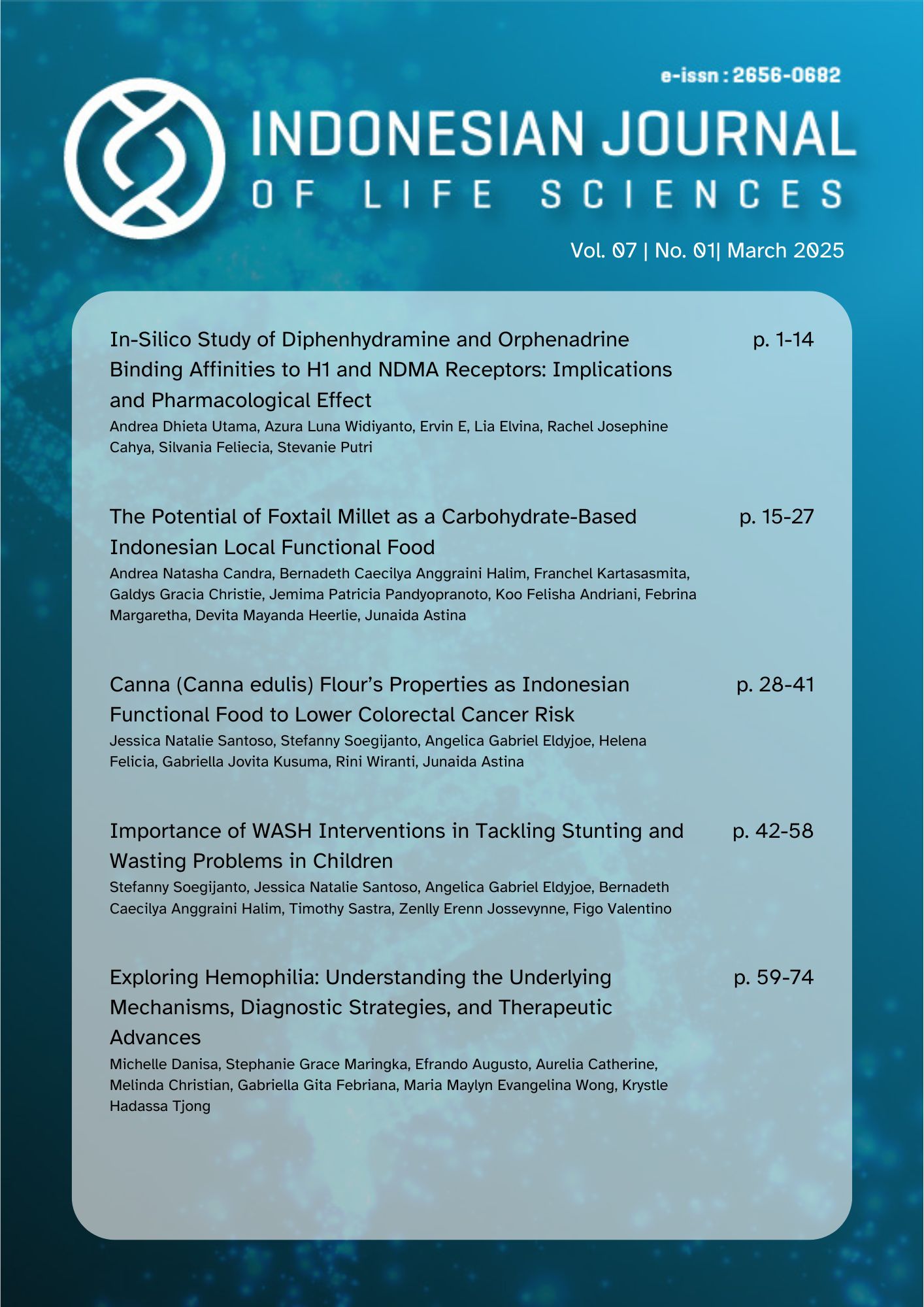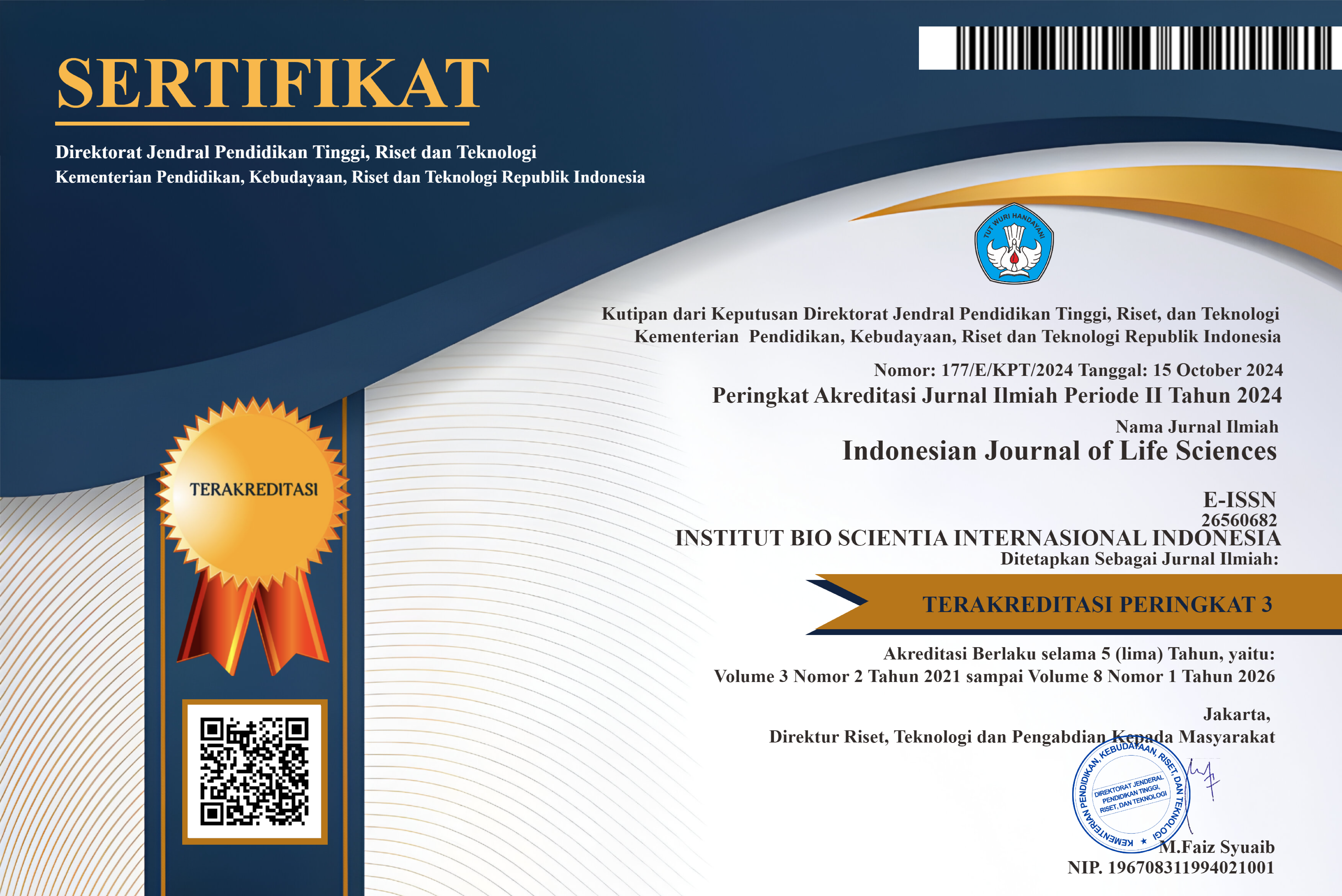Canna (Canna edulis) Flour's Properties as Indonesian Functional Food to Lower Colorectal Cancer Risk
Abstract
The imbalanced food supply in Indonesia has posed a significant challenge. The utilization of canna (Canna Edulis) starch can act as a potential solution, enabling society to consume a more diverse variety of commodities rather than relying solely on rice. Canna, an underutilized tuber, is rich in resistant starch and bioactive compounds, showing potential in tackling dietary and health issues. Despite its high glycemic index, efforts to modify canna starch into resistant starch aim to enhance its health benefits by improving blood sugar control and gut health. This paper aims to introduce ganyong (Canna edulis) starch as a versatile alternative to rice or wheat for carbohydrates, which also highlights the urgent need to address and prevent the high prevalence of colorectal cancer in society by the role of bioactivity and mechanisms of action of canna starch. The applications of canna starch in the food industry such as ginger bangket biscuits, cendol, and cookies, is discussed to highlight its potential as a substitute for traditional starch sources, along with its sensory attributes. Although limitations are acknowledged, continued research and development in processing techniques are essential to unlock the full potential of canna starch and its application in addressing food security and health challenges.
Downloads
References
Aprianita, A. (2010). Assessment of underutilized starchy roots and tubers for their applications in the food industry (Doctoral dissertation, Victoria University).
Bhatt, P., Kumar, V., Goel, R., Sharma, S. K., Kaushik, S., Sharma, S., Shrivastava, A., & Tesema, M. (2022). Structural Modifications and Strategies for Native Starch for Applications in Advanced Drug Delivery. BioMed Research International, 2022, e2188940. https://doi.org/10.1155/2022/2188940
Birt, D. F., Boylston, T., Hendrich, S., Jane, J.-L., Hollis, J., Li, L., McClelland, J., Moore, S., Phillips, G. J., Rowling, M., Schalinske, K., Scott, M. P., & Whitley, E. M. (2014). Resistant Starch: Promise for Improving Human Health. Advances in Nutrition, 4(6), 587–601. https://doi.org/10.3945/an.113.004325
Born, P. (2014). Carbohydrate malabsorption in patients with non-specific abdominal complaints. World Journal of Gastroenterology : WJG, 13(43), 5687–5691. https://doi.org/10.3748/wjg.v13.i43.5687
BPOM RI. 2018. Peraturan Badan Pengawas Obat dan Makanan Nomor 31 Tahun 2018 Tentang Label Pangan Olahan. Jakarta: BPOM RI.
Budiarsih, D. R. (2010). Kajian penggunaan tepung ganyong (canna edulis. Kerr) sebagai substitusi tepung terigu pada pembuatan mie kering.
Burhannudin, Nur Mahmudah, Sitarina Widyarini, & Dewajani Purnomosari. (2018). Chemopreventive Effects of Edible Canna (Canna edulis Kerr.) Against Colorectal Carcinogenesis: Effects on Expression of Adenomatous Polyposis Coli and Inducible Nitric Oxide Synthase in Rat Inflammatory Model. PubMed, 19(3), 839–844. https://doi.org/10.22034/apjcp.2018.19.3.839
Butardo, V. M., & Sreenivasulu, N. (2016). Tailoring Grain Storage Reserves for a Healthier Rice Diet and its Comparative Status with Other Cereals. International Review of Cell and Molecular Biology, 323, 31–70. https://doi.org/10.1016/bs.ircmb.2015.12.003
Carolina, A., & Ilmi, F. N. (2016). Production of Indonesian Canna edulis type IV resistant starch through acetylation modification. International Food Research Journal, 23(2), 491–497.
Chayati, I., Handayani, T. H. W., Nugraheni, M., & Ratnaningsih, N. (2008). Teknologi Pengolahan Pati Garut dan Diversifikasi Produk Olahannya Dalam Rangka Peningkatan Ketahanan Pangan. Jurusan Pendidikan Teknik Boga dan Busana. Fakultas Teknik Universitas Negeri Yogyakarta. Yogyakarta.
Dekker, E., Tanis, P. J., Vleugels, J. L. A., Kasi, P. M., & Wallace, M. B. (2019). Colorectal Cancer. The Lancet, 394(10207), 1467–1480. https://doi.org/10.1016/s0140-6736(19)32319-0
Food and Drug Administration. (2015). Select Committee on GRAS Substances (SCOGS) Opinion: Starches, cereal starches, pregelatinized starch. Derived from https://www.cfsanappsexternal.fda.gov/scripts/fdcc/?set=SCOGS
Handajani, S., Pangesthi, Lucia, T. (2019). Optimization of Ganyong Starch (Canna edulis) on Making of Dry and Instant Noodles. IOP Conference Series: Earth and Environmental Science, 347, 012082. doi:10.1088/1755-1315/347/1/012082
Haggar, F., & Boushey, R. (2014). Colorectal Cancer Epidemiology: Incidence, Mortality, Survival, and Risk Factors. Clinics in Colon and Rectal Surgery, 22(04), 191–197. https://doi.org/10.1055/s-0029-1242458
Harmayani, E., Murdiati, A., & Griyaningsih, G. (2012). KARAKTERISASI PATI GANYONG (Canna edulis) DAN PEMANFAATANNYA SEBAGAI BAHAN PEMBUATAN COOKIES DAN CENDOL Characterization of Edible Canna Starch (Canna edulis) and Its Application as Ingredient for Cookies and Cendol. DOAJ (DOAJ: Directory of Open Access Journals). https://doi.org/10.22146/agritech.9637
Hasri, D. O. (2016). Uji karakteristik amilum dan aktivitas antioksidan umbi ganyong (Canna edulis ker-gawl) dengan metode DPPH secara in vitro.
Herawati, E. R. N., Ariani, D., Miftakhussolikhah, Yosieto, E., Angwar, M., Pranoto, Y. (2017). Sensory and Textural Characteristics of Noodle Made of Ganyong Flour (Canna edulis Kerr.) and Arenga Starch (Arenga pinnata Merr.). IOP Conference Series: Earth and Environmental Science, 101, 012020. doi:10.1088/1755-1315/101/1/012020
Histifarina, Rahman, A., Purnamasari, N. R., & R Rahmat. (2023). Utilization of canna (Canna edulis ker.) as raw material for non-gluten processed food to supporting food diversification program: a review. IOP Conference Series: Earth and Environmental Science, 1246(1), 012045–012045. https://doi.org/10.1088/1755-1315/1246/1/012045
Junior, J. F. dos S. S., & Francisco, A. de. (2020). Cereals & Grains Association. Www.cerealsgrains.org. https://www.cerealsgrains.org/publications/cfw/2020/March-April/Pages/CFW-65-2-0018.aspx
Koida, A., Tanaka, M., Kosaka, R., Okuda, S., Takei, S., Ota, S., Yokoyama, S., Miyake, K., & Watanabe, H. (2024). Canna Starch Improves Intestinal Barrier Function, Inhibits Allergen Uptake, and Suppresses Anaphylactic Symptoms in Ovalbumin-Induced Food Allergy in Mice. Biomolecules, 14(2), 215. https://doi.org/10.3390/biom14020215
Longas, F. F., & Diaz, A. P. (2020). Accumulation dynamics and physicochemical variability of starch in cultivars of Canna edulis Ker. Pesquisa Agropecuária Tropical, 50. https://doi.org/10.1590/1983-40632020v5058827
Louis, P., & Flint, H. J. (2017). Formation of propionate and butyrate by the human colonic microbiota. Environmental microbiology, 19(1), 29-41.
Lovegrove, A., Edwards, C. H., Noni, I. D., Patel, H., El, S. N., Grassby, T., Zielke, C., Ulmius, M., Nilsson, L., Butterworth, P.J., Ellis, P. R., & Shewry, P. R. (2017). Role of Polysaccharides in Food, Digestion, and Health. Critical Reviews in Food Science and Nutrition, 57(2), 237–253.
Malki, M. K. S., Wijesinghe, J. A. A. C., Ratnayake, R. H. M. K., & Thilakarathna, G. C. (2023). Characterization of arrowroot (Maranta arundinacea) starch as a potential starch source for the food industry. Heliyon, 9(9).
Muchsiri , M., Sylviana, & Martensyah, R. (2021). PEMANFAATAN PATI GANYONG SEBAGAI SUBSTITUSI TEPUNG TAPIOKA PADA PEMBUATAN PEMPEK IKAN GABUS (Channa striata). Jurnal Penelitian Ilmu-Ilmu Teknologi Pangan (Jedb) , 10(1). https://doi.org/10.22146/agritech.9637
Mudgil, D. (2017). The Interaction Between Insoluble and Soluble Fiber. Dietary Fiber for the Prevention of Cardiovascular Disease, 35–59. https://doi.org/10.1016/b978-0-12-805130-6.00003-3
Najini, R., Bachri, M. S., & Yuliani, S. (2018). The gastroprotective effects of Canna edulis ker. tuber starch on peptic ulcer and the histopathological profile of rat stomach. Pharmaciana, 8(1), 43. https://doi.org/10.12928/pharmaciana.v8i1.8988
Naowarojna, N., Cheng, R., Lopez, J., Wong, C., Qiao, L., & Liu, P. (2021). Chemical modifications of proteins and their applications in metalloenzyme studies. Synthetic and Systems Biotechnology, 6(1), 32–49. https://doi.org/10.1016/j.synbio.2021.01.001
Nugraheni, M., Lastariwati, B., & Purwanti, S. (2017). The Potential of Gluten Free Flour Enriched with Resistant Starch Type 3 from Canna Edulis for the Management Profile of Glucose, Lipids and Short Chain Fatty Acid in Healthy Mice. Advances in Social Science, Education and Humanities Research (ASSEHR), 112, 120–124.
Nugraheni, M., Lastariwati, B., & Purwanti, S. (2018). The Potential of Gluten Free Flour Enriched with Resistant Starch Type 3 from Canna Edulis for the Management Profile of Glucose, Lipids and Short Chain Fatty Acid in Healthy Mice. Advances in Social Science, Education and Humanities Research (ASSEHR), 112.
Praseptiangga, D., Wandansari, & Widyaastuti, D. (2022). Chemical and physical properties of canna (Canna edulis) and jack bean (Canavalia ensiformis)-based composite flours. Food Research, 6(2), 354–367. https://doi.org/10.26656/fr.2017.6(2).292
Purwitasari, L., Wulanjati, M. P., Pranoto, Y., & Witasari, L. D. (2023). Characterization of porous starch from edible canna (Canna edulis Kerr.) produced by enzymatic hydrolysis using thermostable α-amylase. Food Chemistry Advances, 2, 100152–100152. https://doi.org/10.1016/j.focha.2022.100152
Putri, D. V., & Dyna, F. (2019). Standarisasi Ganyong (Canna edulis ker) Sebagai Pangan Alternatif Pasien diabetes mellitus. Jurnal Katalisator, 4(2), 111. https://doi.org/10.22216/jk.v4i2.4567
Rakhmawati, Y., Gofur, A., Masita, R., Kusumadewi, N. I., & Febriana, I. N. (2022, January). The Proxymate Analysis and Carbohydrate Compound of Rice Analogue Tuber Base as Energy Sources Alternative for Metabolic Syndrome. In 3rd International Scientific Meeting on Public Health and Sports (ISMOPHS 2021) (pp. 56-60). Atlantis Press.
Ratnaningsih, N., Nugraheni, M., Hera, T., Handayani, W., Chayati, I., Pendidikan, J., Boga, T., & Busana, D. (). Retrieved March 14, 2024, from https://staffnew.uny.ac.id/upload/132300107/pengabdian/upload-ibmganyongnov2010docx2.pdf
Rosidah, U., Pratama, F., Yuliati, K., & Hamzah, B. (2013). Hydrolyzed resistant starch from ganyong (Canna edulis Kerr) starch. 13th ASEAN FOOD CONFERENCE 2013 Meeting Future Food Demands: Security & Sustainability, 22-30.
Rakhmawati, Y., Gofur, A., Masita, R., Kusumadewi, N. I., & Febriana, I. N. (2022, January). The Proxymate Analysis and Carbohydrate Compound of Rice Analogue Tuber Base as Energy Sources Alternative for Metabolic Syndrome. In 3rd International Scientific Meeting on Public Health and Sports (ISMOPHS 2021) (pp. 56-60). Atlantis Press.Rudrapal, M., Khairnar, S. J., Khan, J., Dukhyil, A. B., Ansari, M. A., Alomary, M. N., Alshabrmi, F. M., Palai, S., Deb, P. K., & Devi, R. (2022). Dietary Polyphenols and Their Role in Oxidative Stress-Induced Human Diseases: Insights Into Protective Effects, Antioxidant Potentials and Mechanism(s) of Action. Frontiers in Pharmacology, 13. https://doi.org/10.3389/fphar.2022.806470
Rytz, A., Adeline, D., Lê, K. A., Tan, D., Lamothe, L., Roger, O., & Macé, K. (2019). Predicting glycemic index and glycemic load from macronutrients to accelerate development of foods and beverages with lower glucose responses. Nutrients, 11(5), 1172.
Sedyadi, E., & Yuliati, R. T. (2020). Preparation of Ganyong (Canna discolour) Starch Bioplastic with the Addition Of Sirih (Piper betle) Leaf Extract. Journal of Physics: Conference Series, 1594, 012050. doi:10.1088/1742-6596/1594/1/012050
Tanaka, M., Koida, A., Miyazaki, A., Tabata, K., Takei, Y., Tanimoto, Y., Kawamura, M., Tsuzuki, M., Takahashi, H., Yano, T., & Watanabe, H. (2023). Canna starch improves immune functions and the intestinal environment in mice. Bioscience of Microbiota, Food and Health. https://doi.org/10.12938/bmfh.2022-068
Tanaka, M., Koida, A., Miyazaki, A., Tabata, K., Takei, Y., Tanimoto, Y., Kawamura, M., Tsuki, M., Takashi, H., Yano, T., & Watanabe, H. (2023). Canna starch improves immune functions and the intestinal environment in mice. Bioscience of Microbiota, Food and Health. https://doi.org/10.12938/bmfh.2022-068
Trachsel, J., Bayles, D. O., Looft, T., Levine, U. Y., & Allen, H. K. (2016). Function and Phylogeny of Bacterial Butyryl Coenzyme A:Acetate Transferases and Their Diversity in the Proximal Colon of Swine. Applied and Environmental Microbiology, 82(22), 6788–6798. https://doi.org/10.1128/aem.02307-16
Yang, B., McCullough, M. L., Gapstur, S. M., Jacobs, E. J., Bostick, R. M., Fedirko, V., Flanders, W. D., & Campbell, P. T. (2014). Calcium, Vitamin D, Dairy Products, and Mortality Among Colorectal Cancer Survivors: The Cancer Prevention Study-II Nutrition Cohort. Journal of Clinical Oncology, 32(22), 2335–2343. https://doi.org/10.1200/jco.2014.55.3024
Yılmaz, & Tugrul. (2023). Effect of ultrasound-microwave and microwave-ultrasound treatment on physicochemical properties of corn starch. Ultrasonics Sonochemistry, 98, 106516–106516. https://doi.org/10.1016/j.ultsonch.2023.106516

This work is licensed under a Creative Commons Attribution-NonCommercial-ShareAlike 4.0 International License.
Articles published in Indonesian Journal Life of Sciences are licensed under a Creative Commons Attribution-ShareAlike 4.0 International license. You are free to copy, transform, or redistribute articles for any lawful purpose in any medium, provided you give appropriate credit to the original author(s) and Indonesian Journal Life of Sciences, link to the license, indicate if changes were made, and redistribute any derivative work under the same license. Copyright on articles is retained by the respective author(s), without restrictions. A non-exclusive license is granted to Indonesian Journal Life of Sciences to publish the article and identify itself as its original publisher, along with the commercial right to include the article in a hardcopy issue for sale to libraries and individuals. By publishing in Indonesian Journal Life of Sciences, authors grant any third party the right to use their article to the extent provided by the Creative Commons Attribution-ShareAlike 4.0 International license.










